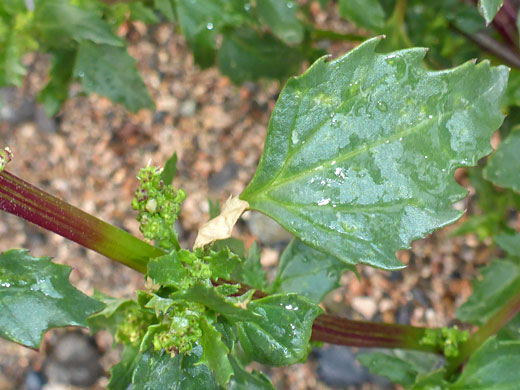Chenopodiastrum Murale, Nettle-Leaved Goosefoot
Plants > Wildflowers > Amaranthaceae > Chenopodiastrum Murale
Common name:
Nettle-leaved goosefoot
Family:
Scientific name:
Chenopodiastrum murale
Synonym:
Chenopodium murale
Main flower color:
Range:
Scattered areas of most of the western states; absent from the Great Plains (non-native)
Height:
Up to 30 inches
Habitat:
Waste ground, arable land, roadsides, disturbed soils; up to 9,000 feet
Leaves:
Triangular to ovate or diamond-shaped, glabrous, toothed; up to 1.5 inches long
Season:
January to December
The leafy stems of chenopodiastrum murale are stout, hairless, grooved, and often reddish. The dark green leaves are hairless, somewhat shiny on the upper surface and whitish-powdery underneath (more so when young), and are lined by a few large, irregular teeth. They have a midvein and a pair of branched lateral veins. Leaf margins are often reddish-purple. This species is native to Europe and Asia, and has become established in many parts of the US, as a weed, most commonly on disturbed ground.
The petal-less flowers are formed of five green or reddish sepals, enclosing five stamens and two stigmas, often not opening fully, or at all, only when mature, to reveal the scale-like fruit. Flowers are arranged in dense panicles, at the upper leaf nodes.
The petal-less flowers are formed of five green or reddish sepals, enclosing five stamens and two stigmas, often not opening fully, or at all, only when mature, to reveal the scale-like fruit. Flowers are arranged in dense panicles, at the upper leaf nodes.
All Contents © Copyright The American Southwest | Comments and Questions | Contribute | Site Map



